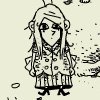Daymare Cat, Appelogen review
June 23, 2013
 Het spelletje Daymare Cat is al weer een pareltje van de hand van Mateusz Skutnik in de hem kenmerkende geschetste tekenstijl.
Het spelletje Daymare Cat is al weer een pareltje van de hand van Mateusz Skutnik in de hem kenmerkende geschetste tekenstijl.
Aan jou om de heldin Cat doorheen de wonderlijke straatjes van het stadje Daymare te loodsen op zoek naar vijf platen die uiteindelijk zullen zorgen voor de muzikale verlossing.
Alhoewel Daymare Cat een platform game is, is Mateusz er op meesterlijke wijze in geslaagd de nadruk te leggen op het oplossen van de puzzels en het verkennen van de locaties. En dat verkennen wordt puur genieten gelet op de zorg waarmee ieder scherm werd getekend.








 So I am in the middle of a very interesting collaboration with Cat Janhke ( I promise I don’t sing) and as a result I had the distinct pleasure to talk to both Cat Jankhe and Mateusz Skutnik about another very interesting collaboration, Seriously.
So I am in the middle of a very interesting collaboration with Cat Janhke ( I promise I don’t sing) and as a result I had the distinct pleasure to talk to both Cat Jankhe and Mateusz Skutnik about another very interesting collaboration, Seriously.